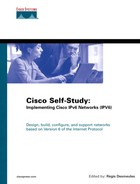Chapter 5. IPv6 Integration and Coexistence Strategies
“There is no reason anyone would want a computer in their home.”
—Ken Olsen, President, Chairman, and Founder of Digital Equipment, 1977
The IPv6 protocol has been designed from the beginning with transition in mind to maintain complete backward compatibility with IPv4. Unlike the Y2K bug, there is no D-day for the switch from IPv4 to IPv6 networks on the Internet. The complete conversion of the Internet to IPv6 will be a long transition period during which IPv6 networks will have to communicate and coexist with IPv4 networks. The transition is expected to take several years.
After reading this chapter, you should understand the main integration and coexistence strategies (defined by IETF) provided in IPv6 to enable a smooth transition of IPv4 networks to IPv6. This chapter also includes examples and configurations of the integration and coexistence mechanisms supported by the Cisco IOS Software.
The NGtrans IETF working group was created to design tools, protocols, and mechanisms that might be used to allow the transition of IPv4 networks toward IPv6. The IETF has defined several mechanisms and protocols for the transition since 1996. This chapter covers the most-used integration and coexistence strategies, especially those supported in the Cisco IOS Software.
Integration and coexistence strategies presented in this chapter are divided into three classes:
Dual stack— The host, server, and router on a network might handle an IPv4 stack and an IPv6 stack simultaneously. When the two stacks are used on nodes connected to networks in which both protocols are enabled concurrently, the dual-stack mode provides the flexibility for nodes to establish end-to-end sessions over either IPv6 or IPv4.
Tunneling— Tunneling allows the isolated IPv6 host, server, router, and domain to communicate with other IPv6 networks over the existing IPv4 infrastructure. Even isolated IPv6 hosts might have to establish end-to-end IPv6 sessions using IPv4 as the transport layer. Tunneling consists of encapsulating IPv6 packets into IPv4 packets and then sending these encapsulated packets to an IPv4 destination node over an IPv4 network. The destination node performs the decapsulation to extract IPv6 packets. Several techniques to deploy and establish tunnels over IPv4 are defined for the tunneling strategy.
NOTE
Dual-stack support is required on nodes to tunnel IPv6 packets in IPv4.
Protocol translation— It is possible for IPv6-only nodes on the IPv6 network to communicate with IPv4-only nodes on the IPv4 network. However, these mechanisms require protocol translation between IPv4 and IPv6 at the edge of the two types of networks.
